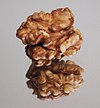Walnuts
|
Walnut kernel, halves
|
|
| Nutritional value per 100 grams | |
|---|---|
| Energy | 2,738 kJ (654 kcal) |
|
13.71
|
|
| Starch | 0.06 |
| Sugars | 2.61 |
| Dietary fiber | 6.7 |
|
65.21
|
|
| Saturated | 6.126 |
| Monounsaturated | 8.933 |
| Polyunsaturated | 47.174 |
|
15.23
|
|
| Vitamins | |
| Vitamin A equiv. |
(0%)
1 μg
(0%)
12 μg9 μg
|
| Vitamin A | 20 IU |
| Thiamine (B1) |
(30%)
0.341 mg |
| Riboflavin (B2) |
(13%)
0.15 mg |
| Niacin (B3) |
(8%)
1.125 mg |
| Pantothenic acid (B5) |
(11%)
0.570 mg |
| Vitamin B6 |
(41%)
0.537 mg |
| Folate (B9) |
(25%)
98 μg |
| Vitamin B12 |
(0%)
0 μg |
| Vitamin C |
(2%)
1.3 mg |
| Vitamin E |
(5%)
0.7 mg |
| Vitamin K |
(3%)
2.7 μg |
| Minerals | |
| Calcium |
(10%)
98 mg |
| Iron |
(22%)
2.91 mg |
| Magnesium |
(45%)
158 mg |
| Manganese |
(163%)
3.414 mg |
| Phosphorus |
(49%)
346 mg |
| Potassium |
(9%)
441 mg |
| Sodium |
(0%)
2 mg |
| Zinc |
(33%)
3.09 mg |
| Other constituents | |
| Water | 4.07 g |
|
|
|
|
|
| Percentages are roughly approximated using US recommendations for adults. Source: USDA Nutrient Database |
|
A walnut is the nut of any tree of the genus Juglans (Family Juglandaceae), particularly the Persian or English walnut, Juglans regia. Technically a walnut is the seed of a drupe or drupaceous nut, and thus not a true botanical nut. It is used for food after being processed while green for pickled walnuts or after full ripening for its nutmeat. Nutmeat of the eastern black walnut from the Juglans nigra is less commercially available, as are butternut nutmeats from Juglans cinerea. The walnut is nutrient-dense with protein and essential fatty acids.
Walnuts are rounded, single-seeded stone fruits of the walnut tree commonly used for the meat after fully ripening. Following full ripening, the removal of the husk reveals the wrinkly walnut shell, which is usually commercially found in two segments (three-segment shells can also form). During the ripening process, the husk will become brittle and the shell hard. The shell encloses the kernel or meat, which is usually made up of two halves separated by a partition. The seed kernels – commonly available as shelled walnuts – are enclosed in a brown seed coat which contains antioxidants. The antioxidants protect the oil-rich seed from atmospheric oxygen, thereby preventing rancidity.
Walnuts are late to grow leaves, typically not until more than halfway through the spring. They secrete chemicals into the soil to prevent competing vegetation from growing. Because of this, flowers or vegetable gardens should not be planted close to them.
The two most common major species of walnuts are grown for their seeds – the Persian or English walnut and the black walnut. The English walnut (J. regia) originated in Persia, and the black walnut (J. nigra) is native to eastern North America. The black walnut is of high flavor, but due to its hard shell and poor hulling characteristics it is not grown commercially for nut production. Numerous walnut cultivars have been developed commercially, which are nearly all hybrids of the English walnut.
...
Wikipedia

